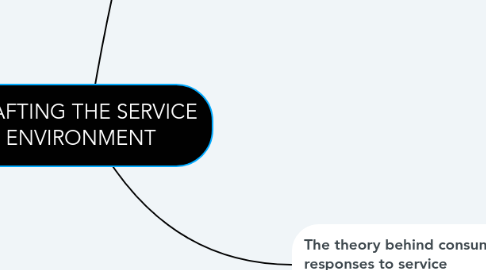
1. The purpose of the service environments
1.1. Shape customers’ service experiences and behaviors
1.2. Signal quality and position, differentiate, and strengthen the brand
1.3. Core component of the value proposition
1.4. Facilitate the service encounter and enhance productivity
2. The theory behind consumer responses to service environments
2.1. Feeling
2.1.1. The Mehrabian-Russell Stimulus-Response model
2.1.1.1. Holds that the conscious and unconscious perceptions and interpretation of servicescape influences how customers feel, then drives customer responses to those environments.
2.1.1.2. Environmental stimuli and cognitive processes → affective response: pleasure and arousal → response behavior: approach or avoidance (time, money spent) and Cognitive processes (perception of quality and satisfaction)
2.1.2. Pleasure and arousal interact on response behaviors, whereby arousal generally amplifies the effects of pleasure or displeasure
2.1.3. Russell’s Model of Affect
2.1.3.1. Customers’ feelings (or emotions) can be modeled with the two interacting dimensions of pleasure and arousal.
2.1.3.1.1. Pleasure is a direct, subjective response to the environment, depending on how much an individual likes or dislikes it.
2.1.3.1.2. Arousal refers to how stimulated the individual feels, largely depending on the information rate of an environment.
2.1.3.2. Together, they determine whether people approach an environment and spend time and money in it or whether they avoid it.
2.1.4. Affective and Cognitive Processes
2.1.4.1. Affective Process
2.1.4.2. Cognitive Process
2.1.5. Behavioral consequences of affect
2.1.5.1. If the environment is pleasant, increasing arousal can generate excitement and lead to a stronger positive response.
2.1.5.2. If a service environment is inherently unpleasant, increasing arousal levels will move customers into the “distressed” region.
2.2. The servicescape model
2.2.1. Ambient Condition
2.2.1.1. Perceived Servicescape
2.2.1.1.1. Employee Response Moderator
2.2.1.1.2. Customer Response Moderator
2.2.2. Space/Function
2.2.3. Signs, Symbols and Artifacts
